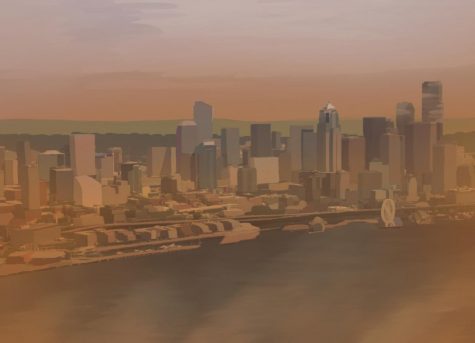A Smoky Washington

Washington and the Pacific Northwest had a smoky August and September, with news reports having headlines like in 2018 when Kiro-7 did this article, “Seattle’s Air Quality Is Currently Worse Than Beijing’s.” Another one from 2017 was “Pacific Northwest Fires Smother Region in Smoke and Ash” from the New York Times.
Younger people, like eighth grader Elena Pozzo, say that the smoke is becoming something normal.
“Honestly, It’s been part of life for me now, I don’t remember a time at the beginning of the school year, every year. But I think it was [when the smoke first came to Seattle] around 2017,” said Ms. Pozzo.
While smoke has come to Seattle before, it’s gotten a lot worse.
The fact of young people like Ms. Pozzo having forgotten a day in late August that doesn’t have smoke makes her mad.
“This type of thing [the bad smoke levels] shouldn’t be normalized, and people with minor respiratory conditions shouldn’t be stuck in their houses not being able to go outside,” said Ms. Pozzo.
While Washington had it bad, this year, we had it much worse, as we had especially had a dry and hot summer, with it only raining 0.17 inches (compared to 0.70 inches) in July, according to the Seattle weather blog, and with people struck in inside their homes, due to the pandemic, people did more stuff in the woods. For example, the number of people that went to Mt Rainier, according to King 5, went up compared to the previous year.
Having humans as the main source, with anywhere from 85% to 90% of wildfires are started by humans, more humans in the woods means more forest fires. But the real problem behind smoke levels in Seattle that were hazardous, and towns in Washington that are now rubble like Malden this year, is climate change, according to middle school science teacher Tom Strouse.
The hotter and drier summers that climate change causes will be very good starting forest fires because there’s more dried kindling to get the fire roaring. And as we’re on track to have hotter summers, we’re not emitting less co2, in fact since 2000, we have increased our emissions by 50% globally, according to Reuters. That means if we don’t do anything, we’ll blow past the 1.5 Celsius warming limit set by the IPCC (the Intergovernmental Panel on Climate change, a UN agency), and go straight for 3.2 Celsius, according to the BBC.
But today the US is repealing environmental standards and laws, like President Obama’s clean power plant rules, which President Trump has repealed. If we want to move forward, according to Mr. Strouse, we need a national carbon tax, so that companies will be incentivized to cut carbon emissions. But to get any new environmental rules, that will require more action.
“If everyone on the planet works together, we probably can deal with it [Climate Change].” Adelaide Streat, a 7th grader, said.
But if people don’t stop the dangerous effects of climate change, which is looking likely because according to IPCC, the window of opportunity to stop the effects is closing.
Washington needs a backup plan for dealing with the fires, as these fires could get worse. One idea that both Strouse and agree on is controlled burns like the ones in Florida when Tom was growing up there.
“[In Florida, where he grew up] controlled burns were important because they [the fires] were simulating the cycle of natural forest fire in a controlled fashion, so they could rotate through areas, and be managed,” said Mr. Strouse.
This idea would require federal approval as most Washington’s and Oregon’s woods and forests are federally owned.

